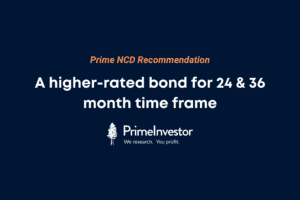The Nifty 50 has rallied 17% in 1 year, the Nifty 50 PE is breaking past peaks, and you’re worried that this may be the end of the party and that you may miss further rallies if it isn’t the end. In uncertain markets like these, there’s a great option to both contain losses and generate returns.
In such uncertain markets, turn to low-volatile options. And when such low-volatile options offer a basket of stocks, it’s even better. The Nifty 100 Low Vol 30 index is such an option. The index picks stocks from the Nifty 100, based on the daily price deviations in the past year. Stocks are ranked based on their volatility score and the 30 least volatile stocks form the index. Each stock’s weight is decided on the volatility score and not on its market cap.

In the current market scenario, we think the Nifty 100 Low Vol 30 is a good addition to long-term portfolios for the following reasons:
- The index does not fall as much as the Nifty 100 or the Nifty 50, across time-frames. Losses in this index are less frequent than the benchmark indexes, and deviations smaller. Should there be any market correction given the quick and dizzying rally in the past several months, this index would therefore fare better than the market.
- The index does not need you to compromise returns even if markets continue to rally. While the index does return lesser than the Nifty 100 during rallying markets, over the course of time, it still beats the Nifty 100.
- Since the index is built using the Nifty 100, it is large-cap by nature. The index has a less-concentrated mix of stocks and sectors compared to the Nifty 100 or the Nifty 50. To this extent, it is a more diversified play than the benchmark index.
The index suits any investor with at least 5-year timeframe. To invest in the Nifty Low Vol 30 index, go for ICICI Pru Nifty Low Vol 30 ETF. This is the only ETF available for the index – but the ETF has improved trading volumes gradually and has low tracking error. We have previously issued a recommendation on this ETF last year, and the index is part of our recommended ETF list.
The rationale for this recommendation is detailed below. Please note that we have used the TRI index where we talk about returns.
Low volatility contains losses
Consider the period from Jan 20 last year, which was the peak before the crash and March 31. In this period, the Nifty 50 shed 29.4%. The Nifty 100 Low Vol 30 fell 21.6%. The reason for the Nifty Low Vol 30’s ability to contain losses is that it comprises stocks where fluctuations in stock prices are low. Relatively limited price movements help keep losses in check. The index is rebalanced every quarter, which also means that it steadily keeps up with the changing market preferences in terms of stocks.
The Nifty Low Vol 30’s volatility and beta are both lower than the Nifty 100. Deviation in 1-year returns in the past 10 years for the Low Vol index stands at 12.5% against the Nifty 100’s 14.7%. The Low Vol index has a beta of 0.8 in this period against the Nifty 100.
Look at the table below. It compares loss performance in different periods between the Nifty 100 and the Nifty Low Vol from 2007 to 2020, a timeline that covers a variety of market scenarios. Notice how the Nifty Low Vol index slips into losses less frequently than the Nifty 100 in different periods, and falls lesser too.
Therefore, should stock markets take a breather from the heady rally it has seen so far, the Nifty Low Vol is well-placed to keep any losses in check. It fares well not just against the Nifty 100 in terms of downside containment, but also large-cap and multi-cap funds.
Still steady on returns
A low beta also means that in rallying markets, the index is going to falter. This does hold for the Nifty Low Vol. Take the period from 2007 to date, which includes the heady 2009 and 2017 rallies. The highest 1-year return the Nifty 100 generated was 112%. The Nifty Low Vol rose 102%. In all 1-year periods where the Nifty 100 gained, the average gain was 22% compared to the Nifty Low Vol’s 20.5%.
Even in the current market rally, the Nifty 100 has done better – between June 2020 to date, the Nifty 50 and Nifty 100 have galloped 48%. The Nifty Low Vol has been sedate at 39%. So you may not be impressed when you see the Nifty rallying and the Low Vol is lagging by a significant margin.
But the charm of a low-volatile strategy is that it doesn’t need big market rallies to deliver. Lower the fall, the lesser it takes to recover and rise. Over time, this translates into better returns. Rolling the Nifty Low Vol’s 3 year returns for the past 10 years has it beating the Nifty 100 90% of the time. The average returns in this period stood at 15.4% for the Nifty Low Vol against the 11.5% for the Nifty 100. Therefore, though the Nifty Low Vol’s role can primarily be to contain losses, it is unlikely to drag overall portfolio returns if held for at least 5 years.
Apart from the above two factors, the Nifty Low Vol is a good portfolio diversifier – especially for those who have more passive portfolios – because its sector and stock weights are far more even than the Nifty 100 or the Nifty 50.
For instance, compare the differential in weight in the top stock and the tenth stock in each index. For the Nifty Low Vol, the top stock is Asian Paints at 4.2% and the tenth stock is HDFC Bank at 3.67%. In the Nifty 100, the top weight is Reliance Industries at 9.3% and the tenth stock is L&T at 2.27%. The wider weight distribution leaves the Nifty Low Vol less vulnerable to single stock movements. For all these reasons, the Nifty Low Vol 30 index is a good bet in uncertain markets.
The other index option is the Nifty Alpha Low Vol 30, which uses two factors – low volatility and alpha. However, the ETF option here, from ICICI Pru, is very new having launched only in August last year and is not yet encouraging on volumes.
Why ICICI Pru Nifty Low Vol 30 ETF
Frankly, the only option to invest in the Nifty Low Vol index is ICIC Pru Nifty Low Vol 30 ETF. There is no index fund. The ETF, launched in 2017, had earlier suffered from lower trading volumes. This, though, has gradually improved especially over 2020. Rolling average 30-day trading value rose from around Rs 10 lakh at the start of 2020 to Rs 50 lakh now. The number of trades executed has similarly shown an improvement.
The ETF has done well on tracking error as well. There is minimal deviation between the NAV and market price, as well as with the Nifty Low Vol 30 index. Deviation in 1-year returns between the index and ETF is just about 0.02% on an average.
Using the ETF
ICICI Pru Low Vol 30 can be used in any of the following ways:
- For portfolios that are heavily aggressive – whether in terms of mid-cap/small-cap allocation or fund strategy – it makes for a good foil to keep losses in check. The quant-based nature of the index and the low beta makes it a good diversifier. However, note that if you already have a good allocation to funds that score on downside containment, such as Parag Parikh Long Term Value, this index may not add much.
- Investors who are worried about uncertain markets or volatility or that markets are overheated, some allocation here can help participation in the market while taking on comparatively lower risk.
- For passive portfolios, it offers strategy diversification as most indices where passive options are available are market-cap based.




21 thoughts on “Prime Recommendation – An ETF for uncertain markets”
Hi, is it correct that ICICI Prudential AMC has filed papers with SEBI to introduce a FOF that invests in their Nifty 100 Low vol 30 ETF?
Hello sir,
ICICI Pru has filed for an Alpha Low Vol 30 FOF. This is a different index from the Low Vol 30.
Thanks,
Bhavana
Bhavana,
Kudos for focussing on “Containing Downside” when the world talks of maximising gains only 🙂
Appreciate also that you have advised a horizon of 5 years and detailing to the point that the “IPru 30 Low Volume ETF” may be not required if one already has “PP LTV Mutual Fund” planned for this term . Please confirm if this understanding is right ?
Second and the bigger question – what about Liquidity? One often hears of liquidity challenges in selling ETFs? Is this apprehension right or it would not affect small retail investors like us ? How should one plan to sell after say 5 years – at one go or in lots and how should one buy it – lumpsum or SEPs ?
thanks and regards,
Prasad
Thanks! Parag Parekh LTE is also adept at containing downsides. You can have both this and IPru Low Vol if the allocation to the PPLTE fund is low, or your investment amount is high and you would like to diversify into different picks. We look at liquidity & tracking error before making ETF recommendations. Where liquidity is reasonable – meaning, it is not high but passable – and error low, we do recommend it but we specifically flag this liquidity and suggest spreading out the investment or exit. Don’t put/remove all the amount in a single trade, but do it across multiple days to reduce liquidity risks.
SIP vs lumpsum – well, this is an equity product, and the same rules regarding other equity funds will apply 🙂 Investing at different points across market cycles always helps.
Thanks,
Bhavana
Hi Bhavana,
Tks for the article. Timely.
I have chosen to invest with DSP Quant Fund – which may have similar characteristics of this ETF? What is your view on the comparison with the DSP fund.
Thank you
Hello Sir, They’re not similar. DSP QUant uses its own set of filters and not low volatility. You can read about it here: https://primeinvestor.in/review-dsp-quant-fund/ thanks, Vidya
mam,i have doubt in investing with ETF specially where is less volume trade ,most of time even market is down also ETF not corrected ,if only sellers selling in pressure mode then only we are getting in good price ,even market 1 or 2 % correction we are not getting good price to buy.so less volume trade i think its risky ,can u suggest about this less volume and how much we can take risky in ETF.
Hello sir,
If volumes are low and tracking error (extent to which market price deviates from NAV & index) is high, then avoid the ETF. Avoid any ATF where tracking error is high. If tracking error is low, but volumes are not very high, then you can spread out your investments and invest (or exit) at multiple times.
Thanks,
Bhavana
Hi Bhavana,
Thank you for this timely recommendation. Can this be paired with the Nippon India ETF Nifty Midcap 150 for containing risk?
Hello sir,
Yes, it can be paired with a Midcap 150 index.
Thanks,
Bhavana
Good check point to keep, the losses minimal. However could you elaborate the difference between Nifty Alpha and Low Volatile stocks ?
Hello sir,
Alpha Low Vol combines two factors to build the index – low vol and a stock’s alpha. We have talked about this index in detail here: https://primeinvestor.in/etf-nifty-alpha-low-vol-30-nfo-winning-index/
Thanks,
Bhavana
Well researched article.
Thanks a lot for the article.
SudhKarudu
Hi Bhavana, Interesting idea. Thanks for the article. What % of Equity Portfolios spread over Active/Passive/Stocks are you suggesting IpruVol30 exposure?
Hello sir,
How much to allocate depends on your portfolio and the other funds you have, because as we said above, if you already have funds that are very strong on downside containment, allocation can be lower. If you’re more conservative, then you can up allocation…so it’s hard to peg an exact number. As a rough guide, you can go up to 15-20% in allocation to the ETF. Hope this helps.
Thanks,
Bhavana
Bhavana, refreshing change – a considered effort, and hopefully thus better balance Risk and Return. Some queries – (a) What portion of allocation should one make to this ETF – and should it be from ones Equity or Debt Allocation (b) Do you advocate SIP or lumpsum investment in it – and at one time or over 5 years ? Lastly, is it true that ETFs are supposedly easy to Buy but relatively difficult to Sell? – and if so, how should one plan the Exit ?
Hello sir,
Allocation needs to come from equity – it is not a debt substitute. It is less volatile than funds and other indices, but it is still equity. So if markets fall, so will this ETF – what it does is keep falls more contained. For the same reason, invest through SIP. How much to allocate depends on your risk and other funds you have already. You can go up to 15-20% in this ETF, but smaller allocations are also fine if you have other low-volatile funds. As long as trading volumes are strong, you will not have issues selling or buying the ETF. Problems on either side come up when liquidity is low – this ETF has steadily been improving in volumes, so it provides comfort. Volumes used to be much lower before, though the ETF still kept tracking error low even then. If volumes in any ETF you want to invest in are low, check if tracking error is also low. If so, then phase out investing or exiting – don’t do it at one go. If tracking error is high, then avoid the ETF.
Thanks,
Bhavana
Tried buying the ICICI PRU LOW VOL 3O. Could not buy thru Axis securities. Kindly advise the code.
bala
Hello sir,
You will have to check with your brokerage if you cannot locate the ETF. The NSE link for the ETF is here: https://www.nseindia.com/get-quotes/equity?symbol=ICICILOVOL
Thanks,
Bhavana
Comments are closed.